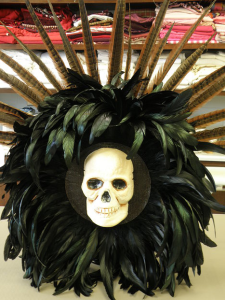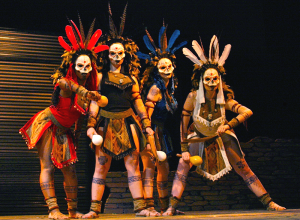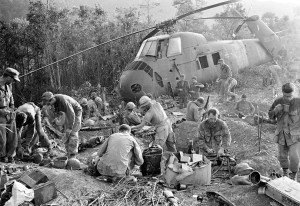When reading Vea’s “God’s Go Begging” I could not help but be reminded of my favorite novel, “The Things They Carried” by Tim O’Brien. O’Brien’s novel is strikingly similar, not only due to the fact that both works revolve around the Vietnam war, but that they both capture the burden of the memories accrued by the soldiers during the deployments in what is known as one of America’s few failed wars. O’Brien’s novel functions greatly to make known the atrocities and inhumanities he witnessed during the war as a conduit for closure as he expresses in this interview “a palpable obligation to do justice to the savagery” he witnessed in Vietnam. His novel does greatly to illustrate the psychological burden that, not only he, but all those who survived their deployments, carry with them and how the atrocities they witnessed perpetually cling to them and shape them into the men they are today. I think the sentiments expressed in this interview by O’Brien do well to parallel the situation of Jesse Pasadoble, along with Vea, in that they are unable to deny the tragedy and the reality of the war. The experiences Jesse had in Vietnam are tethered to him and pervade every aspect of his life as he is continually reminded of them as he works through this murder trial. This interview and its similarities to the psychological burden placed on Jesse in “Gods Go Begging” lends valuable insight to this classes study of the gothic as it illuminates the horror that haunts these veterans throughout their lives. Not only are the settings of San Francisco and the war-torn country of Vietnam gothic in themselves, but the intangible aspects of the war that both Vea and O’Brien have brought back, preventing them from completely returning to reality, are gothic products as well.
As mentioned in class Vea and Jessie lead similar lives. Though he claims the creation of Jessie is a mere character in his novel, some argue that Jessie is a reflection of Vea himself.
Though similarities can be drawn from reading the short biography on Vea in the book, there are many events in his life that are not addressed.
Vea grew up in Phoenix, Arizona in what’s known as the “Buckey Road.” His book, “La Maravilla,” is a reflection that experience if anyone is interested. Vea was raised by his grandparents who instilled in him Spanish and Yaqui heritages and mestizo identity.
When he was ten, Vea took him to California where he worked as a migrant farm worker along Mexican and French Canadian braceros; and where he learned to read and write from his Filipino friends.
Vea attended Cal Berkley and spent time living in Sonora, Mexico before he was drafted into the Vietnam War in 1968. After the war he moved to Paris and worked as a janitor before he was sent back to the states. He returned to Berkley and earned an undergraduate degree in English and Physics, and a law degree. Before he entered private practice, Vea was a public defender.
His experiences as a lawyer inspired his writing career; he has said that he started writing in 1989, after the judge on one of his cases stated he hadn’t been aware that there were any Mexican lawyers.
All of these aspects are interesting when applied to “god’s go begging,” and I can see why people argue that Jessie’s character is a reflection of Vea’s own self.
In an interview for the LA Times, he said: “I’m writing for all these poor people in my life whom I love–all those farm workers, Hindus, Koreans, Filipinos, everybody–so they finally have one of their own who has the discipline and energy to say who they are.”
He also added that his work and writing help him deal with his experiences in Vietnam.
Perhaps many critics are correct in thinking that Jessie is a mirror to Vea’s life. In my opinion, based off Vea’s biography, Jessie’s character is highly influenced by Vea’s life.
Here is the link to the L.A. Times interview if anyone is interested.
</
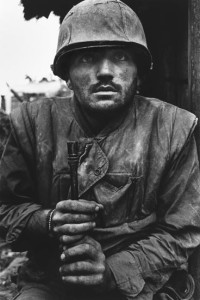 In Gods Go Begging, Alfredo Vea narrates the America’s most contested war, the fight against the communist regime in Vietnam, through the experiences of a solider belonging to the marginalized class and two women who lost their husbands in the war effort. These characters are unable to lead fulfilling lives because they are prisoners of their violent memories, which ruin every chance they have at redemption. Although possessing a collective memory is essential for societal progress, especially when it comes to issues of war, the intimate relation of these people with the Vietnam War prevents them from flourishing; they relive their traumas everyday. The presence of this memories create troubled characters whose past is as relevant as their present—those painful images of bloodshed and lost become gothic reminder of the ephemeral nature of life and the futility of hoping for happiness after the trauma of a war.
In Gods Go Begging, Alfredo Vea narrates the America’s most contested war, the fight against the communist regime in Vietnam, through the experiences of a solider belonging to the marginalized class and two women who lost their husbands in the war effort. These characters are unable to lead fulfilling lives because they are prisoners of their violent memories, which ruin every chance they have at redemption. Although possessing a collective memory is essential for societal progress, especially when it comes to issues of war, the intimate relation of these people with the Vietnam War prevents them from flourishing; they relive their traumas everyday. The presence of this memories create troubled characters whose past is as relevant as their present—those painful images of bloodshed and lost become gothic reminder of the ephemeral nature of life and the futility of hoping for happiness after the trauma of a war.
The protagonist, the clever attorney Jesse Pasodoble has difficulties dealing with reality thanks to the dominant presence of his traumatic memories from the war, which disrupt his present relationships and compromise his ability to cope with life beyond the battlefield. Jesse is an isolated young man despite his intelligence and caring nature. He favors solitude because engaging with others requires an awareness and mental focus he cannot master. The memories of his war experience corrupt the normalcy of even the simplest moments; his everydayness is filled with ghosts that refuse to abandon him. Vea uses his incessant memories to enhance the gothic atmosphere of his novel. Each location is described in grim terms of desolation and psychological darkness. Jesse’s room is an example of gothic style, Vea describes his room as “minefield of empty bottles” which Jesse has to cross to open a window which might allow him breath in the “air of the harsh present” (Vea,215). This haunted room is the perfect place for Jesse’s nightmares to emerge. Jesse experiences this unconscious excursions to the place of war with vividness which borderlines in reality; this impressive images leave him with a lasting and renewed feel of fear and impotence. “Last night his own living spirit had been kidnapped from his room and taken there… for a quick lesson, a reminder that his soul would never leave that hill” Jesse reflects, voicing his inability to move on from the trauma of combat. The cruelty of his memories is evident in this line, Vea personifies them as evil teachers that capriciously play with Jesse’s brain, never really bringing him to madness (which could take him back to that place “for a reunion” forever) but keeping his mind well enough to survive in normal society but not to live peacefully. Jesse concludes that despite the years, the different location, and his accomplishments, he would never be able to let go of his suffering and fear.
The murdered women Persephone and Mai are also victims of this psychological torture. Although their husbands fought at opposite sides, they nourished a friendship based on widowhood, a shared culinary interest and a need to start all over. This plan to move on seems to be working out rather well, however, they are still suffering and this grief is depicted throughout their lovely home. The portraits of their husbands decorate their walls, reminders of glorious times when solitude was an unknown malady. Persephone is still tormented by a photograph of her husband and her in the zoo because it brings back happy memories while emphasizing her current state after his death. The memory of an unfortunate miscarriage also assaults her precarious happiness; the pain she feels is so strong that she stops taking showers, since she lose her child while showering, and is forced to rant manically when she dares take one. Persephone’s monologue is her way of fighting the influence of memory and like a “boy walking through a cemetery fills the air with whistling “ she uses her loud voice as an antidote against silence and its consequential wave of fear (Vea,11).
Mia is also haunted by her past, though her pain is not so conspicuous. Her creepy treasures, the burnt trinkets that were given to her after her husband’s death, are evidently gothic. With these sad objects, which are placed in a visible space assuming a sentimentally powerful role in their home, Vea taints Mia’s lively character with a reminder of her pain and inner darkness.
These examples prove that in Gods Go Begging memories have a huge impact on the lives of the victims of Vietnam. These characters are deprived of their mental sovereignty by the ghosts of their past; memory forces them to perpetually relive the belligerent scenes that shaped them forever.
IMAGE CREDIT:
Shellshocked US Marine, Hue, Vietnam, Don McCulling.
Throughout the reading of The Hungry Woman, I imagined in my mind what the costumes and setting would look like. There were different renditions of la llorana x medea which could create an intriguing yet grotesque look. A google search led me to find costumes ranging from the woman wearing an shawl, looking like an abuelita, to one of the woman dressed in Greek attire, more akin to Medea. The costumes which I found the most interesting were the ones used for the production in Winthrop University. The costumes were created by Carrie Hilliard.
I think it is important to look into the mind of the author Alfredo Vea Jr. to see what he was thinking while he wrote this novel. In doing so I was able to find to two interviews in which Vea explains his time in Vietnam as well as his experience post war as a criminal defense attorney. However, in both of these interviews he doesn’t elaborate on how much this experience played a part in the novel. That being said it is interesting to see how much his own life models the novel. It would be interesting to see if there was any interviews of his experience in Vietnam. In the interview conducted by the Red Wheelbarrow Literary Magazine Vea explains how he was a combat soldier. His descriptions of the horrors of war correlate to the descriptions of dismemberment and devastation – which the author describes as a Gothic frieze (page 194)- during Jesse’s flashbacks to his time of war.
http://faculty.deanza.edu/helfmansuzanne/stories/storyReader$1857
http://articles.latimes.com/1993-06-28/news/vw-8079_1_poor-people
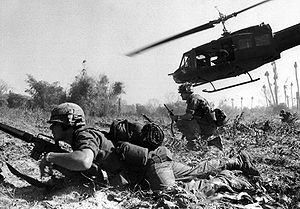 Within Gods Go Begging, one of the first scenes we see is the image of two dead bodies wrapped around one another. We later learn that these deaths were due to a senseless killing. Shortly after, we enter Jesse’s life, and are shown the terribly brutal and emotionally riveting story of his time in Vietnam. Watching his friends have their lives stripped away, smelling the hot, humid air that carries the smell of a decomposing corpse to his nostrils, each and every night holding onto life as the firefight with the North Vietnamese continues. However traumatizing Jesse’s experience within Vietnam was, it is the ramifications of these episodes that produce greater harm.
Within Gods Go Begging, one of the first scenes we see is the image of two dead bodies wrapped around one another. We later learn that these deaths were due to a senseless killing. Shortly after, we enter Jesse’s life, and are shown the terribly brutal and emotionally riveting story of his time in Vietnam. Watching his friends have their lives stripped away, smelling the hot, humid air that carries the smell of a decomposing corpse to his nostrils, each and every night holding onto life as the firefight with the North Vietnamese continues. However traumatizing Jesse’s experience within Vietnam was, it is the ramifications of these episodes that produce greater harm.
Even decades after the war, Jesse still faces post traumatic distress, shown to us vividly through both his flashback dreams as well as his inability to connect with anyone on a deep, sincere level. Jesse’s life fits into many gothic themes: first of all, he is completely isolated. Although he has friends, a girlfriend, and a job as a public defense attorney, he is ultimately alone. His inability to love Carolina and show any meaningful affection towards her is a key example of how Jesse’s time in Vietnam has severely affected his life back home. Jesse’s self-described personality of “stone” reveals how nothing after the war is meaningful: after enduring something so awful, Jesse can never live normally again.
Continuing with Jesse’s isolation is another gothic element of internal conflict. Jesse’s dreams, his flashbacks, his memories of his dead soldiers, his memories of his Vietnamese friend who was subjected to the inhumanity of having a screw driver clear his memory and take his life, all have a profound affect on Jesse and his mind. He never feels at ease: he is constantly rubbing his old dog-tags from the war to bring him comfort; always turning back to his jade piece in search of comfort and relief. Jesse seems aware of his disconnectedness with his girlfriend, yet can’t seem to rectify his inability to become closer with her. We see Jesse admire and adore Carolina, and even shed light on his awareness of his coldness to her, yet despite all this, Jesse simply can’t bring himself to feel any emotion or any deep connection. The war turned him to stone, he says. After experiencing the war, nothing back in regular life is real to Jesse — nothing matters like it did in Vietnam.
Another gothic element that I saw within the novel is the notion of the abject and the uncanny, as we have discussed within class. During the war, and the descriptions of the war, we see a great deal of uncertainty, of fear, fear of the unknown. While fighting on the hill, Jesse and his fellow soldiers say that they are so close to the enemy they can hear their voices; this eerie and unsettling instance was one point in particular that reminded me of the abject. The Vietnamese are the other — they are the unknown, the unidentified of whom the soldiers are fighting against. Their whereabouts, their strategy, their strength, are all, for the most part, unknown to the soldiers. They are left to fight this unknown enemy: an enemy that has a substantial upper-hand due to their knowledge of the terrain in which they are located. It is the fear of the unknown, the fear of not knowing what is going to happen, who is going to survive to see the sunrise, that is a profound gothic element within these war scenes.
Photo: us.history.com
Vietnam can be seen as a sort of gothic space in the novel “Gods Go Begging.” It is a place where a diverse U.S. army is forced to fight together. The army includes African Americans, Native Americans and Mexicans fighting for the United States. These are all cultures that are seen as outsiders in the United States. They are forced to fight for a country that normally oppresses them.
These oppressed men are thrown into a strange foreign country that they know nothing about. The war that they are fighting is brutal and bloody, and death is occurring all around them. The landscape of Vietnam, as portrayed in the book, is a constant war zone with charred grass and mutilated bodies scattered all around. The trees and flowers are twisted and destroyed. Body parts of soldiers are strewn across the battle field. The air is smoky and permeated with the smell of death. The deafening sound of gunshots and explosives is constant.
There is a constant fear of death and the American Soldiers are obviously not wanted there. The soldiers who return home, however, find that they don’t belong there either. They are forced back into the gothic space that is Vietnam because they no longer have a life in the United States. In this sense, Vietnam can be seen as a place filled with death and blood where outsiders are sent to fend for themselves. They are exiled to this wasteland to fight for a country that will never acknowledge them.
image: www.boston.com
 Monday, March 10 we’re going to begin the discussion of Gods Go Begging by Alfredo Véa. Look for the gothic elements of the novel. We’ll also be discussing gothic imagery and war.
Monday, March 10 we’re going to begin the discussion of Gods Go Begging by Alfredo Véa. Look for the gothic elements of the novel. We’ll also be discussing gothic imagery and war.
Hills in “Gods Go Begging” often are depressing places of despair, horror and desperation. The key scene where Jesse Pasadobles gets caught in a gunfight in Vietnam takes place on a hill and it is on that hill that he and his comrades realize that they were merely decoys to throw off the Vietcong’s attempts to intercept their communications. It is on the hill that the chaplain goes mad and abandons his fellow soldiers. Hills feature prominently in the chaplain’s mad inner dialogue as he is carried down the river and stumbles over terrain like a Vietnam War era King Lear. Hills hold secrets. At first the legend was that his family had gold and silver in the hills, but it is later revealed the secret of the house on the hill was that the chaplain was Jewish, something his family hid from the townspeople.
The chaplain returns to a hill, though not his ancestral one or the one in Vietnam. The hill he returns to is Portero Hill, a depressing, crime and poverty filled area of San Francisco. It many ways it reminded me of the depiction of Arizona in “The Hungry Woman.” It is described as filled “with discards and heaps of trash on the hillside had begun to fuse with the industrial rubble down below to form a wide, formless mass of fast food wrappers, rusted metal, plastics and paper soaked in rainwater and engine oil.” It is described almost as military like, describing the projects as, “the dreary rows of buildings had been painted with a muddy, battleship gray enamel that had been detonated by the naval shipyard just before it was shut down (160).” It is covered with graffiti that is described as a camouflage that even the military can’t match. The denizens of the hill lead hopeless lives and the combination of trash and industrial pollutants make them “lose their cultural memory” and apparently any intelligence. It is a depressing account. But the chaplain returns to redeem himself and watch over Mai and he is the one that blessed Persephone and Mai as they lay dying.
It is difficult to get an accurate read on Potrero Hill, though. Jesse Pasadobles does not seem to be a reliable narrator and his description of Potrero Hill is fantastically nihilistic. In contrast, when Peresphone is describing their potential restaurant location, she tells Mai that she found a perfect spot for their restaurant on Potrero Hill telling her, “it’s a beautiful little business location with living space in the back….but best of all, behind the house is a beautiful little hill (246-47).” Even this instance of hope on the hill is shortlived, though, since both Mai and Persephone get murdered there.
Throughout “Gods Go Begging”, hills symbolize both loss of hope and redemption. It is the sight of the lowest of human misery, loss of human life, and shameful secrets. But through processing the painful past, Jesse and the chaplain especially, face their inner demons and come to a sort of uneasy peace and absolution.
In the video the Chicano movement is explained. It all began with Reyes Lopez Tijerina who said that the heirs of the southwest lands are still resented of the distribution of the land grants that were taken illegally from the original land owning families. Reyes lopez tijerina studied treaty law and wanted to reclaim tierra amarilla the land of their people. He was a man on white horse and with tremendous charisma and turned spirit of a movement. Occupation of carson national force allianza was blamed and he was jailed. There was a meeting to take land property with the motto, “down with federal anarchy” and district attorney stopped the convention. This is when the movement of the Chicanos began. They were aware that the government only wanted them as labor, to fight in the war and work for low paying wages. There was also a bitter history of discriminatory experiences. Many didn’t have education and were very poor.
A cabinet committee was created but eventually that proved to not be enough and Corky Gonzalez came into the scene. With his poem “I am Joaquin”, he reached out to the youth and joined Martin Luther King in the walks for justice against the poor of minorities. In Denver, the first singular march crusade for justice immediately drew surveillance from FBI and J. Edgar Hoover. The only purpose of the marches were to make the U.S. understand that the right of the southwest lands wereMexican as well as American, the home of Azlan. They were not wet backs or illegal foreigners but part of the ancestral lands and wanted to engage in this countries own ideals from the Bill of Rights; freedom, peace, liberty and equality.
Here is a very intesting and relevant excerpt from Hispanic Civil Rights Series : Enriqueta Vasquez and the Chicano Movement : Writings from el Grito del Norte.
Here we see the struggle of identity through land rights and ownership.
“El Grito del Norte”
“This land is your land, this land is my land, this land was meant for you and me,” those are some of the words of a beautiful song written by Woody Guthrie. Then we have the sayings of Zapata, Mexico’s beautiful Indian revolutionary, “This land belongs to those that plant the seeds, water the fields, and gather the crops,” “La tierra le pertenece al hombre que la trabaja con sus propias manos.” Land is a beautiful part of man’s relationship to nature. How does this refer to the Southwest? The Indians lived here in great freedom. The history books look upon them as primitive, I believe they were totally free humans living the way of beauty. Then the Spaniards came along. It was a turmoil, they made slaves of the Indians. They forced the Indians to work in the mines and then they would send the gold to Spain. The Spaniards did live near the Indian Pueblos and intermarry. From here come the mestizo. The slavery of the Indian occurred all through the continent and Mexico fought for freedom from Spain. With this independence from Spain, the Southwest lived under the rule of Mexico. Mexico, having economic and internal problems after its war with Spain, was not able to defend its land and thus the Southwest became part of the U.S. I have heard the Southwest called “a colony of the U.S.”
Many people in the past have questioned the individual owning of “land.” And the more I see of people being forced to the city because of rich land owners wanting more land, the more I think and wonder about land ownership. I see land as something that belongs to everyone. Land is like air and life. It is part of each and every one of us. It belongs to the peoples . Tribal ownership was very just and served the needs of the communities. Did you know the government subsidizes big land holders not to plant their land because it will upset the economy of the open market? We have to have a “boom” in this country while people all over the world go to bed hungry. This subsidy thing is taking an interesting trend. For example, we have a senator of the U.S. that received $176,000 a year for holding land and doing nothing with it. Can you imagine? And in Colorado, a large rubber company bought a huge amount of land in southern Colorado and hasn’t plowed one inch of it, BUT the company is receiving money from the government for owning it! Who gets a profit from these land laws? Not the little guy like you and I, but the rich landowners— this is how they get rich and powerful. They make their own laws and know how to use them for personal benefit. I don’t know how you look at this, but it sure smells fishy to me. I believe that the little people are getting took again. The worse part of it is that when we have a few people receiving welfare, etc. we are looked down on and called “leeches.” We are supposed to feel guilty and inferior while the big landowners, the really rich guy, is getting richer from the government. But what he gets is not called a welfare handout— it’s a SUBSIDY. 2 They can get all this money from the government and are looked upon as having— what do you call it, incentive and motivation, I think . . .
You know this thing called money and business is really out of hand and we can see the monster more and more as it reveals itself. Let’s expose every corner. Let’s see what really goes. It looks like the big giant has problems. One of the things that we can begin to do is to start planting our lands, instead of just letting them lay there. Let’s start thinking in terms of feeding ourselves instead of feeding the grocery stores. Cooperatives are certainly a big answer for the people. Let’s go back to being more self-sufficient. Why do we have to support Mr. Safeway, whoever or wherever he may be? Let’s work our land. Then the land will come back to the peoples and it will belong to those who plant the seeds, water the fields and gather the crops. Entre más y más vemos que los ricos se van apoderando de tierras y aunque no se ocupan en plantarlas y el gobierno les paga [solamente] por tenerlas en su poder. Hasta hay compañías que empiezan a comprar tierras con el fin de que les paguen nada más por ser dueños de ellas. Ya basta de esto, de mantener al hombre rico y darle dinero a los negocios. Vamos a empezar a trabajar nuestras tierras, vamos a juntarnos, ya sea en cooperativas o sea como sea. Ya dejemos de darle tanto dinero a las tiendas. El modo del indio era tener tierras para las comunidades y trabajarlas juntos para el uso de la gente. Ésta era costumbre de nosotros. ¿Por qué no lo podemos hacer de vuelta? Recuerden que “La tierra le pertenece al hombre que la trabaja con sus propios manos”, eso decía Zapata y también decía, “Tierra o muerte”. 3 April 14, 1969″
Works Cited
Chicano! PBS Documentary “Quest for a Homeland” YouTube
Vasquez, Enriqueta. Hispanic Civil Rights Series : Enriqueta Vasquez and the Chicano Movement : Writings from el Grito del Norte. Oropeza, Lorena. Houston, TX. Arte Público Press, 2006.

